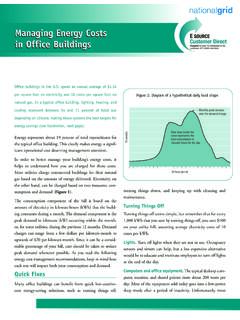Transcription of Understanding Electric Demand - National Grid
1 For National Grid's Commercial Customers in New York Understanding Electric Demand What you need to know to make cost-saving energy-use decisions. At National Grid, we're committed to kWh Electrical energy actually used electricity itself, or the cost of product, . bringing you consistent, reliable energy (Energy). Example: Ten 100-watt lamps, largely made up of fuel costs incurred in at the lowest possible cost. Part of that when on for one hour, consume 1 kilo- the actual generation of energy. commitment involves providing you watt-hour (kWh). Both consumption and Demand charges with information and expertise to help 1 Horsepower Under full load, con- are part of every electricity consumer's you use electricity more efficiently.
2 After sumes power at the rate of approximate- service bill. Residential customers pay all, the more you know about using elec- ly 1 kilowatt (kW) hour per hour. one rate of charges for electricity serv- tricity, the more you can save on energy- ice, covering both consumption of elec- related costs. Of course, using electricity What Is This Thing Called tricity and Demand . This simple, com- wisely and economically is really up to you. Understanding Demand not only Demand bined charge is possible because there is The price we pay for anything we buy relatively little variation in electricity use what it is but why it exists is a good contains the cost of the product plus from home to home.
3 Place to start. profit, plus the cost of making the prod- This is not the case among commercial Defining Our Terms uct available for sale, or overhead. In and industrial energy users, whose elec- seeking to understand Demand , we tricity use both consumption and kW Rate of using electricity ( Demand ). might equate it to this type of overhead Demand vary greatly. Some need large Example: Ten 100-watt lamps consume expense. This is in contrast to charges amounts of electricity once in a while . electricity at the rate of 1,000 watts, or 1 National Grid customers pay for the others, almost constantly. Complicating kilowatt, or 1 kilowatt-hour per hour.
4 This is the fact that electricity cannot be stored. It must be generated and sup- plied to each customer as it is called for instantly, day or night, in extremely variable quantities. Meeting these cus- tomers' needs requires keeping a vast array of expensive equipment trans- formers, wires, substations and even generating stations on constant standby. The amount and size of this equipment must be large enough to meet peak con- sumption periods, , when the need for electricity is highest. ionalgr d natio Utilities and public service commissions Comparing Demand and A Demand meter's needle advances as around the country have determined Consumption electricity consumption increases, just as that the most equitable way to cover the On every Demand -billed customer's your speedometer needle advances as cost of this equipment is to have those energy service bill, charges for con- your speed increases in a car.
5 When you customers who create this Demand and sumption and Demand are separate. stop the car, the needle moves back to the need for power during these peaks This exaggerated example illustrates zero, regardless of the highest miles per pay for its availability. For this reason, how the two work: Suppose you have a hour reached on the trip. utilities spread the costs of this extra commercial building with lighting, Unlike a speedometer needle, Demand equipment among all commercial and cooling, machinery, and miscellaneous meters record the highest average kilo- industrial customers as a separate Electric equipment. Its fully installed watts reached and maintained in a 15- charge for Demand .
6 Load totals 15 kW. You are not using the minute interval within the billing period. building and have no employees. On the If your Demand reaches 50 kW, for Defining Demand Customers first day of each month, you come into example, and stays there for 15 minutes, National Grid installs a Demand meter the building and turn on all electrical the meter needle remains at 50 kW. whenever a customer's energy con- equipment and leave it on for 15 min- unless or until your Demand exceeds sumption has exceeded 2,000 kilowatt- utes. Then you shut everything off again that level. If your Demand later reaches hours (kWh) per month for four con- and lock up the building until the fol- 55 kW and stays there for 15 minutes, secutive months.
7 Once Demand billing lowing month. What would your elec- the needle will then stay at 55. The new begins, it does not end until after the tric bill look like? It would show very index point is maintained, even when monthly energy consumption has been little consumption; in fact, only 4 kWh, at you are using electricity at below 55. less than 2,000 kWh for 12 consecutive a cost of about 28 cents. (Added to kW, until the meter reader comes to months. This requirement may not be National Grid's basic service charge of record the Demand and resets the meter avoided by temporarily terminating $ per 30-day period, which includes back to zero.)
8 Service. New or existing customers maintenance of gas or Electric lines, whose connected load indicates that the metering and other costs such as meter 20. 10 kW 15 25. energy consumption will exceed 2,000 reading and billing, the total is $ ). kWh per month will have a Demand But what about your Demand charge? At 10. 5. 30. = $208. meter installed. The Demand charge will an average cost of $ per kW and the 15 kW 0. be the highest average kW measured in meter reading at 15 kW, the Demand a 15-minute interval during the billing Simultaneous Use charge would be $ * (for cus- period, but not less than one kW and tomers in Service Classification No.
9 2, not less than the Demand contracted Small General Service- Demand ). For example, suppose you have a 10 kW. for. motor in one part of the building and a Customers who do not create peaks but Basic service 15 kW motor in another. If you operate charge and electrical $ both units simultaneously, the Demand maintain a relatively level Demand are Service consumption 4 kWh from meter will record 25 kW. known to have a high load factor. March 3. Electrical Demand Utility pricing policies are designed to to 15 kWh $ However, if you can use the motors April 3. pass savings on to these customers. alternately, operating the 10 kW unit AMOUNT NOW DUE $ only when the 15 kW unit is off, the maximum Demand reading will be only National Grid customers billed on the Demand price who provide the trans- formers required to take service, as des- ignated by National Grid, have their charges reduced by $.
10 90 per kW billed. Understanding Demand Metering Much like your car's odometer records accumulated mileage, Electric meters record consumption (kWh). Electric Demand meters function like your speedometer with an important difference. 15 kW. The 10 kW saved would save Demand Ratchet Clause about $83 per month, or $996 per year. The Demand ratchet clause applies only to National Grid customers on 10 kW 20 Large General Service Classifications 15 25. receiving service under 15,000 volts OR 10. 5. 30. = $125. whose monthly measured Demand 15 kW 0 equals or exceeds 100 kW. At times, there will be a difference between these cus- Alternate Use tomers' recorded Demand as taken from the meter by our meter reader and the Some intermittently used equipment billing Demand that the customer pays.






